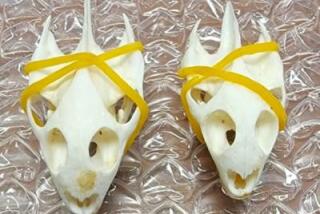U.S. wildlife agency destroys 6 tons of contraband ivory

- Share via
The U.S. Fish and Wildlife Service pulverized about 6 tons of confiscated elephant ivory Thursday in an effort to strip the items of their value and make a statement against poaching.
Photographs taken before the event show ivory boxes, intricately carved statues and staffs, masks and countless pieces of jewelry, all stuffed into crates ready to be crushed. Afterward, only fragments remained.
The ivory was seized over the last 25 years during undercover investigations of smuggling operations or at the U.S. border, according to the wildlife service.
The items were destroyed with an industrial rock-crusher at the wildlife service’s National Wildlife Property Repository on the Rocky Mountain Arsenal National Wildlife Refuge near Denver. The agency is deciding what to do with the fragments left by the crusher.
On July 1, President Obama issued an executive order aimed at improving efforts to fight poaching and animal trafficking in Africa. The reorganization of U.S. trafficking agencies came with $10 million in new aid and led to the formation of the first council to advise the government on ways to improve domestic and international efforts to fight poaching and illegal wildlife trafficking.
“The survival of protected wildlife species such as elephants, rhinos, great apes, tigers, sharks, tuna, and turtles has beneficial economic, social and environmental impacts that are important to all nations,” the executive order says. “Wildlife trafficking reduces those benefits while generating billions of dollars in illicit revenues each year, contributing to the illegal economy, fueling instability, and undermining security.”
Elephants are slaughtered for the ivory in their tusks and teeth. It is generally illegal to import or export African elephant ivory in the United States.
Between 1900 and the late 1980s, the world population of African elephants dropped from more than 10 million to fewer than 500,000. Although elephant populations began to recover in the 1990s, a resurgence in demand for elephant ivory and meat caused populations to fall again. Over the last 10 years, the population of forest elephants fell by an estimated 62% across central Africa, according to the wildlife service.
“The United States is part of the problem because much of the world’s trade in wild animal and plant species – both legal and illegal – is driven by U.S. consumers or passes through our ports on the way to other nations,” wildlife service Director Daniel Ashe said.
African elephants, the largest land mammals, have been listed as threatened under the Endangered Species Act since 1978. They are found across central and southern Africa. In 1988, Congress passed the African Elephant Conservation Act, which imposed a moratorium on the import of African elephant ivory.
Thursday’s event was the first time the agency has destroyed the contraband ivory it collects. The Philippines, Kenya and Gabon have all destroyed large quantities of ivory.
“Rising demand for ivory is fueling a renewed and horrific slaughter of elephants in Africa, threatening remaining populations across the continent,” Interior Secretary Sally Jewell said in a statement. “We will continue to work aggressively with the Department of Justice and law enforcement agencies around the world to investigate, arrest and prosecute criminals who traffic in ivory.”
ALSO:
Man falls 2,000 feet out of plane off Florida coast; search on
Ohio stay of execution raises questions about inmate organ donations
States that opened parks during government shutdown want reimbursement
Twitter: @skarlamangla
More to Read
Sign up for Essential California
The most important California stories and recommendations in your inbox every morning.
You may occasionally receive promotional content from the Los Angeles Times.











